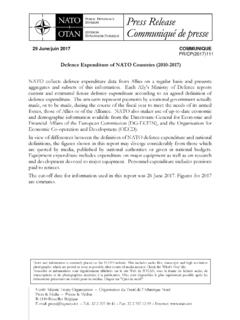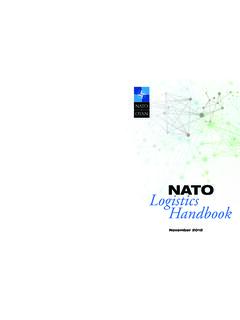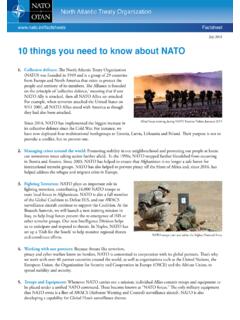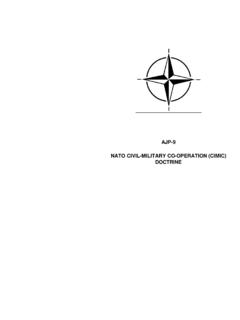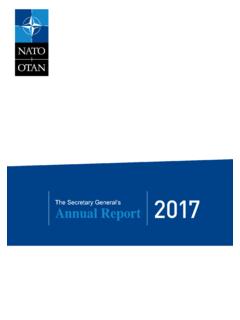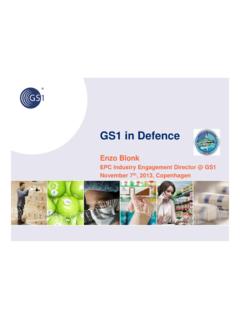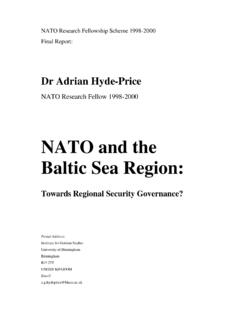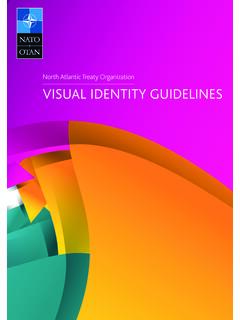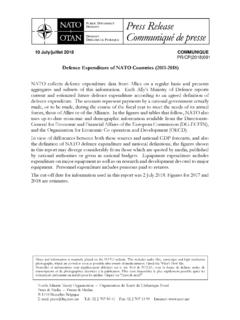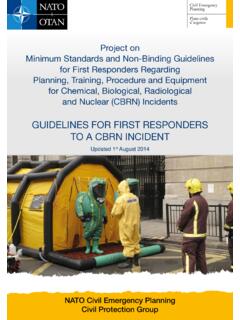Transcription of NATO 2030
1 He Parties to this Treaty reaffirm their faith in the purposes and princi-ples of the Charter of the United Nations and their desire to live in peace with all peoples and all are determined to safeguard the freedom, common heritage and civilisation of their peoples, founded on the principles of democracy, in-dividual liberty and the rule of law. They seek to promote stability and well-being in the North Atlantic are resolved to unite their efforts for collective defence and for the preservation of peace and security. They therefore agree to this North At-lantic Treaty : Article 1 The Parties undertake, as set forth in the Charter of the United Nations, to settle any international dispute in which they may be involved by peaceful means in such a manner that international peace and security and justice are not endangered, and to refrain in their international relations from the threat or use of force in any manner in-consistent with the purposes of the United 2 The Parties will contribute toward the further development of peaceful and friendly international relations by strengthening their free institutions, by bringing about a better understanding of the principles upon which these institutions are founded.
2 And by promoting conditions of stability and well-being. They will seek to eliminate conflict in their in-ternational economic policies and will encourage economic collaboration between any or all of 3 In order more effectively to achieve the objectives of this Treaty, the Parties, separately and jointly, by means of continuous and effective self-help and mutual aid, will maintain and develop their individual and collective capacity to resist armed 4 The Parties will consult together whenever, in the opinion of any of them, the territorial integrity, political independence or security of any of the Parties is 5 The Parties agree that an armed attack against one or more of them in Europe or North America shall be considered an attack against them all and consequently they agree that, if such an armed attack oc-curs, each of them, in exercise of the right of individual or collective self-defence recognised by Article 51 of the Charter of the United Na-tions, will assist the Party or Parties so attacked by taking forthwith, in-dividually and in concert with the other Parties, such action as it deems necessary, including the use of armed force.
3 To restore and maintain the security of the North Atlantic such armed attack and all measures taken as a result thereof shall immediately be reported to the Security Council. Such measures shall be terminated when the Security Council has taken the measures necessary to restore and maintain international peace and security .Article 6 1 For the purpose of Article 5, an armed attack on one or more of the Parties is deemed to include an armed attack:on the territory of any of the Parties in Europe or North America, on the Algerian Departments of France 2, on the territory of Turkey or on the Islands under the jurisdiction of any of the Parties in the North Atlantic area north of the Tropic of Cancer; nato 2030:United for a New EraAnalysis and Recommendations of the Reflection Group Appointed by the nato Secretary General25 November 202021.
4 Preface 32. Introduction and Main Findings 5 A Strategic Anchor in Uncertain Times 5 nato s Political Legacy: Adapting to Change 7 A Political Role Suited to a New Era 9 Vision 11 Main Findings Moving Toward nato 2030 123. Analysis: The Security and Political Environment 2010-2030 16 The Security Environment: The Return of Systemic Rivalry and Rise of Global Threats 16 The Political Environment: Strains on Allied Unity 204. Recommendations: Strengthening nato s Role, Cohesion, and Consultation 22 nato s Political Purpose in the 21st Century 22 Strengthening nato s Political Role and Tools with regard to Emerging Threats and Challenges from Every Direction 22 Russia 25 China 27 Emerging and Disruptive Technology 29 Terrorism 32 The South 34 Arms Control and Nuclear deterrence 36 Energy Security 39 Climate and Green Defence 41 Human Security and Women, Peace, and Security 43 Pandemics and Natural Disasters 44 Hybrid and cyber Threats 45 Outer Space 47 Strategic Communications, Public Diplomacy.
5 And Tackling Disinformation 48 Strengthening nato s Political Cohesion and Unity 50 Strengthening nato s Political Consultation and Decision-Making 53 Political Consultation among Allies 53 Political Consultation with the European Union (EU) 55 Political Consultation with Partners 57 Political Decision-Making 60 Political Structure, Staffing, and Resources 625. Conclusion 64 Chronology 6631 PrefaceAt the North Atlantic Treaty Organization ( nato ) Meeting of Heads of State and Government in London in December 2019, Alliance leaders asked the nato Secretary General Jens Stoltenberg to undertake a Forward-Looking Reflection Process to assess ways to strengthen the political dimension of the nato Alliance.
6 To this end, in April 2020, Secretary General Stoltenberg appointed an independent Reflection Group co-chaired by Thomas de Maizi re and A. Wess Mitchell and consisting of John Bew, Greta Bossenmaier, Anja Dalgaard-Nielsen, Marta Dass , Anna Fotyga, Tacan Ildem, Hubert V drine, and Herna Secretary General tasked the Group with providing recommendations in three areas:1) Reinforcing Allied unity, solidarity, and cohesion, including to cement the centrality of the transatlantic bond; 2) Increasing political consultation and coordination between Allies in nato ; and 3) Strengthening nato s political role and relevant instruments to address current and future threats and challenges to Alliance security emanating from all strategic inform its work, the Reflection Group conducted extensive consultations within and outside of nato , including with scholars, leaders from business and the technology sector, parliamentarians, military officials, and government representatives from all thirty Allies, most nato partner states, and numerous International Organisations (see Chronology in Annex).
7 Throughout the process, the Group maintained close contact with the Secretary General and provided regular updates on its progress to him and to the North Atlantic Council (NAC).Due to the COVID-19 pandemic, the entirety of the Reflection Process was conducted remotely. Altogether, from the launch of the process to the conclusion of the final text, the Group conducted more than ninety meetings with over two-hundred interlocutors via video teleconference. The fully virtual character of the process is a historic first for nato . This document is the final report of the Reflection Group to the Secretary General. The first part summarises the report, outlines the Group s vision for nato in 2030, and provides a condensed version of the Group s main findings.
8 The second part assesses the main trends that will shape nato s environment between now and 2030. The third part provides a more detailed discussion of the recommendations, organised thematically according to each of the three objectives given to the Group by the Secretary General. The analysis and recommendations offered herein are intended to inform the Secretary General s deliberations in the lead-up to the meeting of nato Leaders in 2021, when he will conclude the Reflection Process by offering recommendations for strengthening nato s political dimension to Allied Heads of State and Government. Throughout this process, the members of the Reflection Group acted as independent experts.
9 As nato moves forward with these deliberations, the group members remain available for further explanation and consultation as Reflection Group would like to thank Secretary General Stoltenberg for his trust and engagement throughout the reflection process. We are grateful to the nato International Staff, in particular Benedetta Berti-Alberti and her team at the Policy Planning Unit for their assistance, and for their tireless efforts to ensure that the Group s countless video teleconferences, week in and week out, ran seamlessly, and on time. We would like to express our appreciation to Simon Herchen and Carsten Schmiedl for their help in coordinating the Group's work and supporting the drafting process, and Claire Yorke for her help in editing the text.
10 Finally, we are grateful to the numerous individuals inside and out-side of nato who briefed the group, as well as the Permanent Representatives to the NAC, the govern-ments of the Alliance and its partners, the nato Parliamentary Assembly, and all who contributed their valuable time, ideas and thoughts to this report. Introduction and Main Findings nato stands as history s most success- ful alliance. nato enters the eighth decade of its existence with both a longer record of success and a wider assort-ment of looming challenges than its founders could have foreseen when they signed the Washington Treaty in April 1949. In the thirty years since the collapse of the Soviet threat that called nato into existence, the Western Alliance has defied innumerable predic-tions of its imminent demise.
